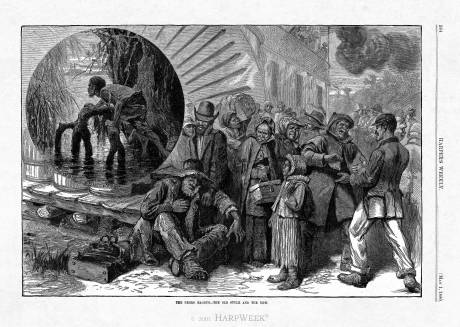
|
|
|
|
|
Click on the image to open a
larger version of the cartoon or read
the caption and explanation. |
|

|
|
The Negro Exodus--The Old Style and the NewArtist: UnknownBlacks left the South for a variety of reasons. The economy of the South, already devastated by the Civil War, suffered further during the economic depression of the 1870s. Southern blacks were vulnerable because the great majority were poor farmers, working under a tenant system that kept them in debt and unable to buy their own land. They were often barred from entering other occupations by the racial prejudice of white employers or, increasingly, by state and local law. In politics, the end of Reconstruction during the 1870s resulted in the disfranchisement of black men through intimidation, violence, or voting restrictions. Finally, there was a strong religious element in the migration to Kansas, which was promoted and perceived as the Promised Land where American blacks could live together and be free of the detrimental effects of bigotry. A leading advocate of the "Great Exodus" was Benjamin Singleton, a former slave from Tennessee who had escaped to the North. He and Columbus Johnson formed a real-estate company that advertised across the South and assisted thousands of blacks in moving to Kansas in 1877-1879. (In later years, Singleton became a black nationalist and started a back-to-Africa movement.) However, the mass migration during its principal years (1879-1881) was the work of many organizers and supporters. Southern blacks received information about Kansas and other areas through letters from settlers, mass meetings, and circulars. Adding to an air of expectancy was the "Exodusters" belief that God was delivering them from their bondage to the Promised Land. Coming mainly from Louisiana, Mississippi, and Arkansas, groups of blacks paid nominal fees to sail up the Mississippi River, then traveled westward to Kansas. In February 1880, shortly before this cartoon appeared, 900 black families arrived in St. Louis en route to Kansas. The size of the black exodus thrust it into the national spotlight, with politicians and the press debating its cause and effect. Although a variety of reasons--economic, political, religious, social, and personal--were involved, most white commentators reduced the issue to one of politics. Republican politicians and newspapers focused on the denial of suffrage to Southern blacks (who voted overwhelmingly Republican). Democrats countered that Republicans sponsored the migration in order to reduce Southern representation in the U.S. House of Representatives (which is based on population). Although Kansas officials had initially encouraged the migration, they began in late 1879 attempting to divert it to Illinois and Indiana. This alarmed Midwestern Democrats, including Senator Daniel Voorhees of Indiana (a state almost evenly divided between the two parties), who introduced a resolution establishing a committee to investigate the cause of the exodus. Senator William Windom, a Republican from Minnesota, tacked on an amendment which required the committee to make recommendations to the full Congress if the cause was found to the suppression of civil rights. The Voorhees Committee held hearings during the early months of 1880, a presidential election year. At its conclusion, the majority Democrats and the minority Republicans issued conflicting reports judging the cause to be that which each had originally assumed it to be. This cartoon contrasts the Great Exodus of 1879-1881 with the plight of a runaway slave in an earlier time (inset picture). Whereas the slave crouches in fear as he hides from a passing steamboat, the Exodusters disembark openly from a riverboat as white men observe from on deck. While some travelers seem weary and harried, the artist conveys a sense of camaraderie and joy. In reality, although some of the black migrants did find success in Kansas, the state did not prove to be the Promised Land for most. They experienced economic privations in what was still called the Great American Desert, and the mass nature of the migration aroused the latent racism of a number of white Kansans. Robert C. Kennedy |
|
|
Cartoon and explanation provided by HarpWeek.Copyright 2001 The New York Times Company and HarpWeek |